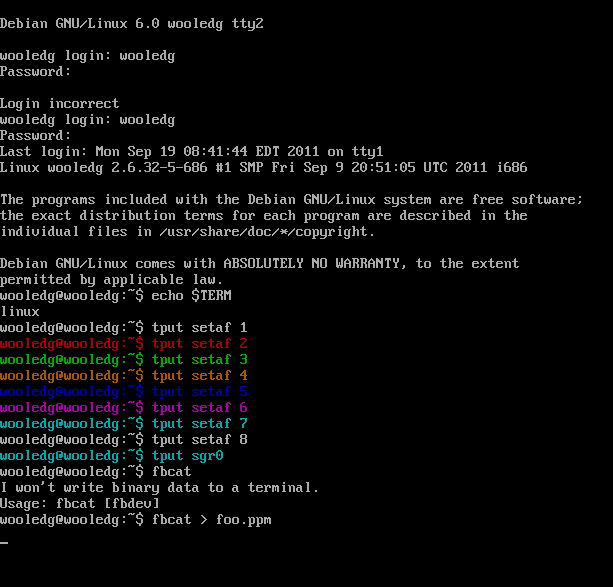How can I print text in various colors?
Do not hard-code ANSI color escape sequences in your program! The tput command lets you interact with the terminal database in a sane way:
# Bourne tput setaf 1; echo this is red tput setaf 2; echo this is green tput bold; echo "boldface (and still green)" tput sgr0; echo back to normal
Cygwin users: you need to install the ncurses package to get tput (see: Where did "tput" go in 1.7?)
tput reads the terminfo database which contains all the escape codes necessary for interacting with your terminal, as defined by the $TERM variable. For more details, see the terminfo(5) man page.
tput sgr0 resets the colors to their default settings. This also turns off boldface (tput bold), underline, etc.
If you want fancy colors in your prompt, consider using something manageable:
# Bash red=$(tput setaf 1) green=$(tput setaf 2) blue=$(tput setaf 4) reset=$(tput sgr0) PS1='\[$red\]\u\[$reset\]@\[$green\]\h\[$reset\]:\[$blue\]\w\[$reset\]\$ '
Note that we do not hard-code ANSI color escape sequences. Instead, we store the output of the tput command into variables, which are then used when $PS1 is expanded. Storing the values means we don't have to fork a tput process multiple times every time the prompt is displayed; tput is only invoked 4 times during shell startup. The \[ and \] symbols allow bash to understand which parts of the prompt cause no cursor movement; without them, lines will wrap incorrectly.
See also http://wiki.bash-hackers.org/scripting/terminalcodes for an overview.
Discussion
This will be contentious, but I'm going to disagree and recommend you use hard-coded ANSI escape sequences because terminfo databases in the real world are too often broken.
tput setaf literally means "Set ANSI foreground" and shouldn't have any difference with a hard-coded ANSI escape sequence, except that it will actually work with broken terminfo databases so your colors will look correct in a VT with terminal type linux-16color or any terminal type so long as it really is a terminal capable of 16 ANSI colors.
So do consider setting those variables to hard-coded ANSI sequences such as:
# Bash white=$'\e[0;37m'
You assume the entire world of terminals that you will ever use always conforms to one single set of escape sequences. This is a very poor assumption. Maybe I'm showing my age, but in my first job after college, in 1993-1994, I worked with a wide variety of physical terminals (IBM 3151, Wyse 30, NCR something or other, etc.) all in the same work place. They all had different key mappings, different escape sequences, the works. If I were to hard-code a terminal escape sequence as you propose it would only work on ONE of those terminals, and then if I had to login from someone else's office, or from a server console, I'd be screwed. So, for personal use, if this makes you happy, I can't stop you. But the notion of writing a script that uses hard-coded escape sequences and then DISTRIBUTING that for other people should be discarded immediately. - GreyCat
I said it would be contentious, but there is an alternative view. A large number of people today will use Linux on their servers and their desktops and their profiles follow them around. The terminfo for linux-16color is broken. By doing it the "right" way, they will find their colors do not work correctly in a virtual terminal on one of the console tty's. Doing it the "wrong" way will result only in light red becoming bold if they use the real xterm or a close derivitve. If terminfo can't get it right for something as common as linux-16color, it's hard to recommend relying on it. People should be aware that it doesn't work correctly, try it yourself, go through the first 16 colours on A Linux VT with linux-16color. I know ANSI only specified names not hue's but setaf 7 is obviously not supposed to result in black text seeing as it is named white. I'd place money on a lot more people using Linux for their servers than any other UNIX based OS and if they are using another UNIX-based or true UNIX they are probably aware of the nuances. A Linux newbie would be very surprised to find after following the "right way" her colors did not work properly on a VT. Of course the correct thing to do is to fix terminfo, but that isn't in my power, although I have reported the bug for linux-16color in particular, how many other bugs are there in it? The only completely accurate thing to do is to hard-code the sequences for all the terminals you will encounter yourself, which is what terminfo is supposed to avoid the necessity of doing. However, it is buggy in at least this case (and a very common case), so relying on it to do it properly is also suspect. I will add here I have much respect for Greycat, and he is a very knowledgeable expert in many areas of IT; I fully admit I do not have the same depth of knowledge as he does, but will YOU ever be working on a Wyse 30? To be completely clear, I'm suggesting that you should consider hard-coded colors for your own profile and uses, if you are intending to write a completely portable script for others to use on foreign systems then you should rely on terminfo/termcap even if it is buggy.
- I've never heard of linux-16colors before. It's not an installed terminfo entry in Debian, at least not by default. If your vendor is shipping broken terminfo databases, file a bug report. Meanwhile, find a system where the entry you need is not broken, and copy it to your broken system(s) -- or write it yourself. That's what the rest of the world has always done. It's where the terminfo entries came from in the first place. Someone had to write them all.

-- GreyCat
